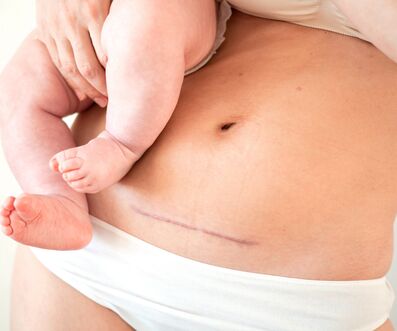Latest news
 Waterless bathing: Supporting dignity and reducing infection riskWaterless bathing boosts patient comfort and helps reduce infection risk using gentle, antimicrobial wash mitts.
Waterless bathing: Supporting dignity and reducing infection riskWaterless bathing boosts patient comfort and helps reduce infection risk using gentle, antimicrobial wash mitts. Reducing Surgical Site Infecton in Cesarean SectionsFor many women giving birth is connected with joyful anticipation. Yet, it also carries certain risks, especially when doctors need to perform a caesarean-section.
Reducing Surgical Site Infecton in Cesarean SectionsFor many women giving birth is connected with joyful anticipation. Yet, it also carries certain risks, especially when doctors need to perform a caesarean-section. 60 seconds with Patrick, Medical Director at Vesismin Health by schülke!Today he gives you exciting insights into his day-to-day work and shows you which tasks and projects make up his varied daily routine.
60 seconds with Patrick, Medical Director at Vesismin Health by schülke!Today he gives you exciting insights into his day-to-day work and shows you which tasks and projects make up his varied daily routine. schülke HR Recruiter TipsAt schülke, we don’t just hire for skills—we hire for mindset. We value those who act with passion, strive for quality, drive innovation, build trust, and believe in the power of collaboration
schülke HR Recruiter TipsAt schülke, we don’t just hire for skills—we hire for mindset. We value those who act with passion, strive for quality, drive innovation, build trust, and believe in the power of collaboration From Dual Student to Department Lead – Mads Gadeberg’s Journey at schülkeCareer paths at schülke are as diverse as the colleagues – and Mads Gadeberg’s story shows what’s possible when dedication meets trust.
From Dual Student to Department Lead – Mads Gadeberg’s Journey at schülkeCareer paths at schülke are as diverse as the colleagues – and Mads Gadeberg’s story shows what’s possible when dedication meets trust. Call for applications for the Hygiene Prize of the Rudolf Schülke Foundation 2026In March 2026, the Rudolf Schülke Foundation will once again award the Hygiene Prize to scientists who have developed outstanding solutions to problems in the fields of hygiene, public health and infection prevention.
Call for applications for the Hygiene Prize of the Rudolf Schülke Foundation 2026In March 2026, the Rudolf Schülke Foundation will once again award the Hygiene Prize to scientists who have developed outstanding solutions to problems in the fields of hygiene, public health and infection prevention.
Our offer for your industry
 HospitalHygiene is of central importance in hospitals. With schülke's comprehensive disinfection and hygiene solutions, we support you in ensuring the highest standards of infection control and protecting patients and staff.
HospitalHygiene is of central importance in hospitals. With schülke's comprehensive disinfection and hygiene solutions, we support you in ensuring the highest standards of infection control and protecting patients and staff. Personal useProtect yourself and your home with the disinfection and hygiene products from schülke. Reliable solutions for everyday use ensure effective protection and safety.
Personal useProtect yourself and your home with the disinfection and hygiene products from schülke. Reliable solutions for everyday use ensure effective protection and safety. Care homeReliable hygiene is crucial in the care sector in order to protect residents and staff. We offer customized disinfection and hygiene solutions that help prevent infections and ensure the highest safety standards in day-to-day care.
Care homeReliable hygiene is crucial in the care sector in order to protect residents and staff. We offer customized disinfection and hygiene solutions that help prevent infections and ensure the highest safety standards in day-to-day care.
Other sectors
 Food industryWith schülke as your partner, you get everything from a single source: products that have been specially developed for the food processing industry, outstanding service and optimum hygiene technology. In short: tailor-made solutions specifically for your requirements.
Food industryWith schülke as your partner, you get everything from a single source: products that have been specially developed for the food processing industry, outstanding service and optimum hygiene technology. In short: tailor-made solutions specifically for your requirements. Doctor's practiceProtect your patients and team with high-quality hygiene products from schülke.
Doctor's practiceProtect your patients and team with high-quality hygiene products from schülke. Emergency servicesRely on schülke's high-quality hygiene products in the emergency services to effectively prevent infections and ensure the safety of patients and staff.
Emergency servicesRely on schülke's high-quality hygiene products in the emergency services to effectively prevent infections and ensure the safety of patients and staff. Pharma & cleanroomschülke helps you to meet demanding legal requirements and to optimize your processes in accordance with current legal standards.
Pharma & cleanroomschülke helps you to meet demanding legal requirements and to optimize your processes in accordance with current legal standards.
Products
For more than 135 years, schülke has stood for pioneering spirit, innovation and quality. Founded by Rudolf Schülke and Julius Mayr in 1889, the Hanseatic disinfectant manufacturer has established itself as an internationally operating and successful company. Today, schülke is one of the market leaders in the areas of infection prevention and hygiene solutions.

Career at schülke
Become part of schülke and shape the future of hygiene and infection prevention with us.
Data protection notice
We use analysis methods (e.g. cookies) to measure how often our website is visited and how it is used. We also use cookies to link your page visits and website usage with your customer data stored in our CRM system in order to be able to address you individually, i.e. based on your interests and usage. We alsowe embed third-party content from other providers (e.g. videos). We have no influence on further data processing and any tracking by the third-party provider.In this context, we also use service providers in third countries outside the EU that may not guarantee an adequate level of data protection, which entails the following risks Access by authorities without informing the data subject, no data subject rights, no legal remedies, loss of control.By hiring us, you consent to the processes described above. You can revoke your consent with effect for the future. You can find more information in our privacy policy
































